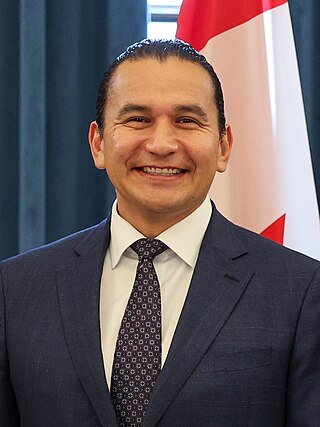
The premier of Ontario is the head of government of Ontario. Under the Westminster system, the premier governs with the confidence of a majority the elected Legislative Assembly; as such, the premier typically sits as a member of Provincial Parliament (MPP) and leads the largest party or a coalition of parties. As first minister, the premier selects ministers to form the Executive Council, and serves as its chair. Constitutionally, the Crown exercises executive power on the advice of the Executive Council, which is collectively responsible to the legislature.

Thomas Walter Scott was the first premier of Saskatchewan from 1905 to 1916. Scott was Saskatchewan's second longest-serving Premier, serving one continuous term from 1905 to 1916). He led the Saskatchewan Liberal Party in three general elections, winning all three with majority governments before retiring. He was the first of six Liberal Premiers to date. He was succeeded by William Melville Martin. Scott was also the minister of various departments during his tenure as premier. Prior to the creation of Saskatchewan in 1905, Scott was a Member of Parliament in the federal House of Commons of Canada, elected in the general elections of 1900 and 1904.

The premier of Manitoba is the first minister for the Canadian province of Manitoba—as well as the de facto President of the province's Executive Council.
In Canada, a premier is the head of government of a province or territory. Though the word is merely a synonym for prime minister, it is employed for provincial prime ministers to differentiate them from the prime minister of Canada. There are ten provincial premiers and three territorial premiers. In most provinces and all territories, these persons are styled the Honourable only while in office, unless they are admitted to the King's Privy Council for Canada, in which case they retain the title even after leaving the premiership. In Nova Scotia and Alberta, former premiers are honorary members of the provincial Executive Council and thereby retain the style the Honourable for life.

The commissioner of the Northwest Territories is the Government of Canada's representative in the Northwest Territories. Similar in certain functions to a lieutenant governor, the commissioner swears in the members of the legislative assembly, swears in members of the executive council, assents to bills, opens sessions of the legislative assembly, and signs other government documents such as Orders in Council.

The Nova Scotia House of Assembly, or Legislative Assembly, is the deliberative assembly of the General Assembly of Nova Scotia. The assembly is the oldest in Canada, having first sat in 1758; in 1848, it was the site of the first responsible government in the British Empire. Bills passed by the House of Assembly are given royal assent by the lieutenant governor of Nova Scotia in the name of the King in Right of Nova Scotia.
Manitoba Finance is the department of finance for the Canadian province of Manitoba.

The Province of Ontario is governed by a unicameral legislature, the Parliament of Ontario, composed of the Lieutenant Governor and the Legislative Assembly, which operates in the Westminster system of government. The political party that wins the largest number of seats in the legislature normally forms the government, and the party's leader becomes premier of the province, i.e., the head of the government.
This is a list of leaders and office-holders of Canada. See also Canadian incumbents by year.
The Government of Saskatchewan is the provincial government of the province of Saskatchewan. Its powers and structure are set out in the Constitution Act, 1867.

The Province of Manitoba, similar to other Canadian provinces and territories, is governed through a Westminster-based parliamentary system. The Manitoba government's authority to conduct provincial affairs is derived from the Constitution of Canada, which divides legislative powers among the federal parliament and the provincial legislatures. Manitoba operates through three branches of government: the executive, the legislative, and the judicial. The executive branch—the Government of Manitoba—consists of the Executive Council and the Premier, who is the head of government and the President of the Executive Council. The legislative branch—the Manitoba Legislature—is composed of the Lieutenant Governor and the Legislative Assembly, which is composed of the 57 members (MLAs) elected to represent the people of Manitoba, as well as the Speaker, the Clerk, the Officers of the Legislative Assembly, and the employees of the legislative service.
The Government of Nova Scotia is the government of the Canadian province of Nova Scotia. The powers and structure of the province are set out in the Constitution Act, 1867. In modern Canadian use, the term "government" refers broadly to the cabinet of the day chosen from the Nova Scotia House of Assembly and the non-political staff within each provincial department or agency – that is, the civil service.
The Government of New Brunswick is the provincial government of the province of New Brunswick. Its powers and structure are set out in the Constitution Act, 1867.

The Government of Newfoundland and Labrador is the provincial government of the province of Newfoundland and Labrador. It was established by the Newfoundland Act and its powers and structure are set out in the Constitution Act, 1867.

The following outline is provided as an overview of and topical guide to Saskatchewan:

The following outline is provided as an overview of and topical guide to Manitoba:

The following outline is provided as an overview of and topical guide to Ontario:

The Legislature of Manitoba is the legislature of the province of Manitoba, Canada. Today, the legislature is made of two elements: the King of Canada in Right of Manitoba, represented by the lieutenant governor, and the unicameral assembly called the Legislative Assembly of Manitoba. The legislature has existed since Manitoba was formed out of part of Rupert's Land in 1870.

The following outline is provided as an overview of and topical guide to New Brunswick:











